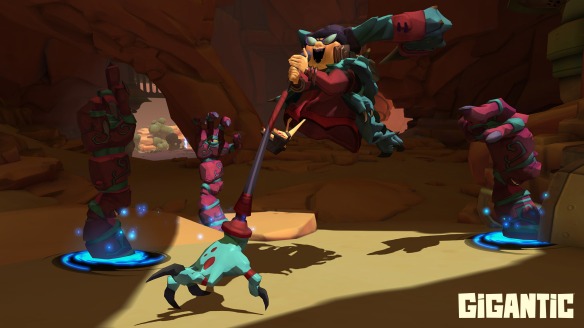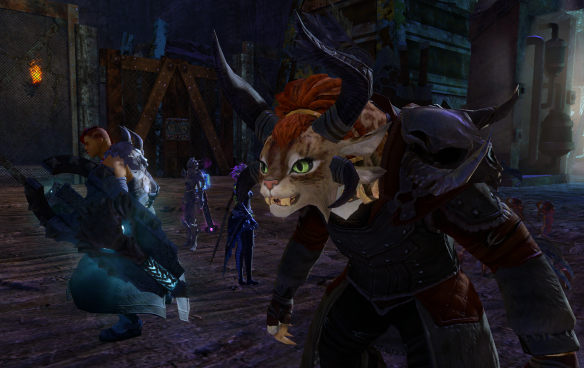 I have no idea why people aren’t raving about this game.
I have no idea why people aren’t raving about this game.
Let me back up a second. Going into PAX East this year, my partner had Gigantic–an upcoming free-to-play MOBA-ish 5v5 online competitive game made by Motiga–pegged as the game he was most interested in checking out at the show. He showed me some trailers, and I was intrigued, but skeptical. It looked beautiful and the characters were striking. But an online competitive game? Not really my thing.
Sunday morning of PAX, he finally convinced me to give it a shot on the show floor. We waited in line for maybe 40 minutes, and then were placed in a match with another couple and a Community Coach, against four other PAX attendees and their own coach. I picked the cute little wizard goblin to play as, and the match began.
We lost pretty badly, but it was so incredibly fun that I didn’t even care. The game is fast, playing almost like a third-person shooter with an emphasis on movement, although each character has a very different role and play style. The twist with this game is that each team has a huge creature called a Guardian on its team. Each team starts out trying to control points on the map and kill other players. Doing this increases your Guardian’s power. When the power meter is full, the Guardian goes on a rampage, stomping across the map to the other team’s Guardian. Your team needs to escort your Guardian to the other end of the map, where it attacks the other team’s Guardian, causing it to be stunned. Then, you are free to wail on the other team’s Guardian. The goal of the game is to knock out the other team’s Guardian.
The combination of the beautiful art, fun and interesting characters, and strategic team-based play added up to something immediately appealing. Even though I’m not a competitive person, and I prefer co-op to competitive games, I found that the teamwork skills I had honed in games like Final Fantasy XI, Guild Wars 2, and even Uncharted horde mode helped me out a lot. Additionally, MOBAs are notoriously inaccessible, and while Gigantic has some complexities–you level up in the middle of a match and choose both passive upgrades and skill upgrades, like other MOBAs–it’s also pretty easy to just jump in. I was able to wail away on enemies and even get a few kills just using my main attack (mapped to the left mouse button), and once I started to get used to using Q, E, and F for the other skills, I found myself being able to pop into a battle, cause some chaos, and escape fairly skillfully. I was able to play two more matches that day, and at each one I played better and better, despite choosing different characters each time.
But the thing that has me really raving about the game to anyone who will listen is the female characters. Out of the 16 heroes revealed so far, 7 are women or girls (and two are genderless: a robot and an agender swashbuckler named Tyto). Not just that, the variety found in the female characters is just fantastic. The character at the top of this post is Imani, a sniper with a truly amazing fashion sense. The goblin wizard I played in the first match is named Mozo, and she’s a girl!
 Other companies or artists would insist on giving her long hair or a bow or pink robes so that you know for certain she’s a girl, but Mozo shows that that’s just not necessary. You can have a female character that isn’t necessarily feminized.
Other companies or artists would insist on giving her long hair or a bow or pink robes so that you know for certain she’s a girl, but Mozo shows that that’s just not necessary. You can have a female character that isn’t necessarily feminized.
There’s also a badass grandma witch named Griselma–when do you ever see female characters over the age of 30 in games?
 On the other end of the spectrum is Aisling, a little girl with a big ol’ sword who can summon the ghost of her dad.
On the other end of the spectrum is Aisling, a little girl with a big ol’ sword who can summon the ghost of her dad.
There’s also Xenobia, a creepy tentacle witch who can drain health; Tripp, a deadly lightning assassin; and Vadasi, a four-armed goddess of judgement who smites her enemies and heals allies. The fact that there are such a variety of female characters that are created to be appealing to everyone and not just straight men makes the game so welcoming to me. It’s obvious the developers want players to want to be these women and girls and female-creatures, not just ogle them.
All the characters in the game have such clear designs and instant personality. And it’s not just set dressing; the designs combine so well with the characters skills that it makes the game that much more fun to play. When I played Mozo I really felt like I was a zany wizard bopping around the field zapping people; when I played Voden, I felt like a lord of the forest, dashing from battle to battle poisoning enemies and protecting our Guardian. It’s all of these components together that make the game instantly special to me and one that I’m looking forward to following its development.
For more about character design in Gigantic, check out:
Mike Williams’s interview with artist Joe Pikop (USGamer.net)
Motiga’s PAX South panel on Hero design (YouTube)
All screenshots are from Gigantic’s official website.






